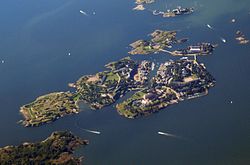
Back سوومنلينا Arabic سوومنلينا ARZ Крэпасць Суаменліна Byelorussian Suomenlinna Catalan Suomenlinna CEB Suomenlinna Czech Suomenlinna Danish Suomenlinna German Κάστρο της Σουομενλίνα Greek Suomenlinna Esperanto
| Suomenlinna Sveaborg | |
|---|---|
 An aerial view of Suomenlinna | |
| Location | Helsinki, Finland |
| Coordinates | 60°08′37″N 24°59′04″E / 60.14361°N 24.98444°E |
| Official name | Fortress of Suomenlinna |
| Type | Cultural |
| Criteria | iv |
| Designated | 1991 (15th session) |
| Reference no. | 583 |
| Region | Europe and North America |
Suomenlinna (Finnish: [ˈsuo̯menˌlinːɑ]; until 1918 Viapori, Finnish: [ˈviaˌpori]), or Sveaborg (Swedish: [ˈsvɛːɑˈborj]), is an inhabited sea fortress composed of eight islands, of which six have been fortified; it is about 4 km southeast of the city center of Helsinki, the capital of Finland. Suomenlinna is popular with tourists and locals, who enjoy it as a picturesque picnic site. Originally named Sveaborg (Castle of the Swedes), or Viapori as referred to by Finnish-speaking Finns, it was renamed in Finnish to Suomenlinna (Castle of Finland) in 1918 for patriotic and nationalistic reasons, though it is still known by its original name in Sweden and by Swedish-speaking Finns. Due to its strategic geographical location, it sometimes used to be known as Gibraltar of the North.[1]
The Swedish crown commenced the construction of the fortress in 1748 as protection against Russian expansionism. The general responsibility for the fortification work was given to Augustin Ehrensvärd. The original plan of the bastion fortress was strongly influenced by the ideas of Vauban, the foremost military engineer of the time, and the principles of the star fort style of fortification, albeit adapted to a group of rocky islands. Famous for these bastion fortifications, Suomenlinna became a UNESCO World Heritage Site in 1991.[2]
During the Finnish War, Sweden surrendered the fortress to Russia on 3 May 1808, paving the way for the occupation of Finland by Russian forces in 1809, and then establishment of Grand Duchy of Finland at the conclusion of the war. The islands were then used as a base for the Russian Baltic Fleet in World War I, with Russia beginning the construction of the Krepost Sveaborg in 1915. Russian forces left after Finland declared its full independence in 1917. Finland then managed Suomenlinna through the Defense Department until turning most of it over to civilian control in 1973.
- ^ Set sail for Suomenlinna: a quick intro
- ^ "Fortress of Suomenlinna". UNESCO World Heritage Centre. United Nations Educational, Scientific, and Cultural Organization. Retrieved 19 September 2021.
© MMXXIII Rich X Search. We shall prevail. All rights reserved. Rich X Search